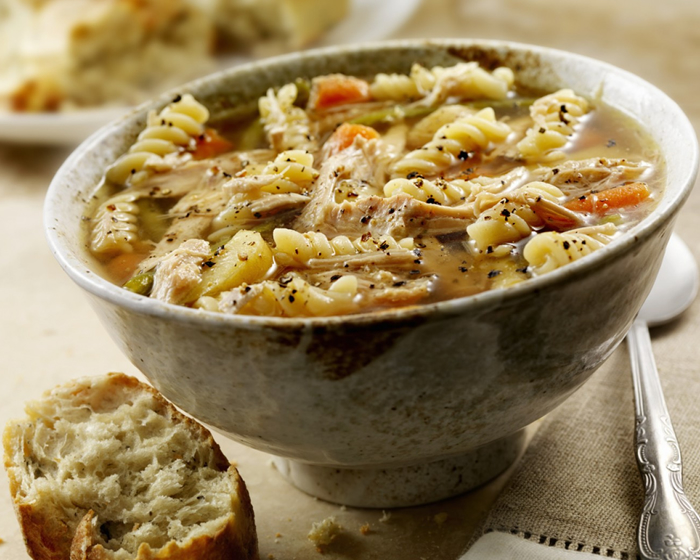Photo credit: (Lauri Patterson/Getty Images/iStockphoto)
Food is supposed to make us feel good — content, fulfilled, connected. It’s meant to comfort us physically by easing hunger and bringing satisfaction, and emotionally by bonding us to others as we share in the experience of a meal.
It works that way from the start, when as babies we fill our bellies blissfully in the arms of a nurturing caregiver. There is no guilt involved then. But somewhere along the road to adulthood, the notion of comfort food takes a wrong turn — it becomes something we crave, even obsess over, but ultimately feel bad about eating. It comes with a moral judgment — often described as “sinful.” We are being “good” when we avoid it. That mind-set is so ingrained in our culture it can be tough to break away, but doing so frees you to look at comfort food in a new way and can help you ultimately to enjoy it healthfully.
So much of what makes a food comforting has to do with the set of experiences, memories and associations around eating it. It’s an edible connection with feeling happy and carefree, having a sense of belonging, and being cared for.
Because of that, it is different for every person. One man’s chicken soup is another’s bibimbap. Buttery, fragrant cinnamon toast gives me the warm fuzzies because my grandmother would make it for me as a child whenever I was home sick from school. For someone who grew up in the South, comfort food might be the sweet potato casserole their mom cooked for holiday dinner. For a New Englander, it could be the clam chowder they ate dockside as a kid every summer vacation. Someone from an Italian family might find solace in a simmering Sunday sauce, whereas chicken and rice could call out to someone with Dominican roots. What you count as comfort food also depends on your gender, with women generally preferring snack foods such as chocolate and ice cream, and men yearning for warm, hearty meals such as casseroles and steak dinners.
There is chemistry involved, too — foods with concentrated carbohydrates, such as sweets and grains, can trigger the body’s production of serotonin, which provides a feeling of calm and well-being. And fatty foods have been shown to light up the reward centers in the brain, reducing feelings of stress and improving mood. The problem is that while these chemical changes once served us biologically by motivating us to seek hard-to-find, calorie-rich foods important to our survival, now these foods are everywhere we turn, so we wind up having to fight our impulses to avoid overeating them.
Luckily there is more to us than simple impulses, and our ability to stop and think before acting can make all the difference. Next time you are about to grab some comfort food, ask yourself: Are you really physically hungry, or are you feeling an emotional hunger that can be addressed in a non-food way? If you are feeling a bit lonely, for example, instead of reaching immediately for the chips, touch base with a friend, write about your feelings in a journal, or even write about the chips themselves. (According to a 2011 study published in Psychological Science, participants asked to write about their experience eating comfort food felt significantly less lonely than those asked to write about eating a new food.) If you are reaching for food because you feel anxious or stressed, try a warm bath, a walk outside or a cup of tea instead of trying to munch your way to calm.
If you are truly, stomach-growling hungry, one way to go when you are yearning for feel-good food is to focus on the inherently healthy dishes on your list. Chicken soup, or just about any soup for that matter, does it for me when I need a culinary hug. For my husband, it’s a roast chicken dinner. There are also plenty of pasta dishes and casseroles that qualify as both comforting and healthy.
Another strategy that often works is to go for a healthier version of what you are craving and experiment with lightened-up versions of classic recipes. If you have a hankering for french fries, crispy baked “fries” might hit the spot just as well. If you typically reach for ice cream, try frozen yogurt. Instead of grabbing a candy bar, try a small square of dark chocolate.
Sometimes though, you are hankering for something blatantly unhealthy, loaded with saturated fat, sugar, salt or all of the above, and no substitute will do. In that case, my suggestion is to have some, but do it mindfully to get every drop of pleasure out of it. Chips, chocolate cake, mac and cheese, whatever it may be — dish out a reasonable portion and slowly savor every bite, guilt-free. Guilt only sets you up for a vicious cycle, making you feel bad about yourself, which leads you to wanting more comfort food. Instead of getting wrapped up in that, eat, enjoy and move on.
One way to make your comfort food experience healthier is to purposefully create joyful memories around nourishing foods. For example, you could start a weekly or monthly afternoon tea with dear friends, so ultimately a cup of tea sipped on your own conjures their company. At your next summer picnic, start a tradition of a watermelon seed or cherry pit spitting contest, so it’s not just ice cream that reminds you of carefree summer days, but healthy fruit too. Go apple or strawberry picking with family or friends each year, and cook up healthy dishes from your bounty. And look beyond baking sweets with the children in your life toward quality time cooking something fun and healthy such as roasted butternut squash or pita chips and dips. It could be just the thing to help them, and you, reap the comforts of good food in a healthy way for the long run.



